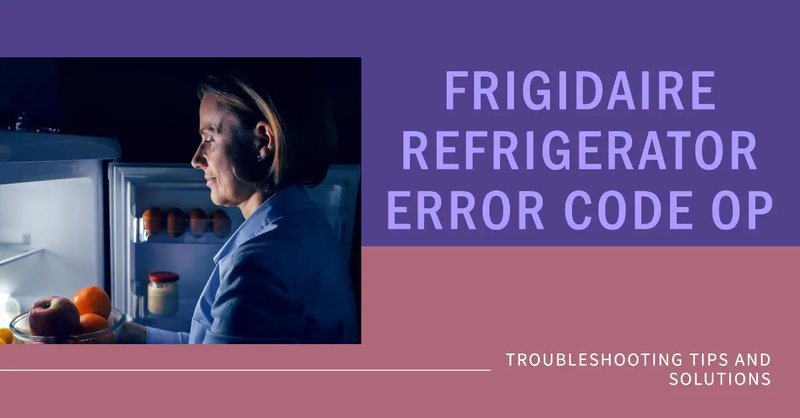
So, what exactly does an F2 error mean? Picture this: your fridge is like this big, cold box that quietly does its job day in and day out. But sometimes, even the best of machines have moments where they just don’t feel like themselves. An F2 error code is a way for your Frigidaire fridge to let you know something’s wrong with its temperature sensors or control board. But what causes this issue, and how can you fix it? Let’s dive in.
Understanding the F2 Error Code
Here’s the deal: the F2 error code in a Frigidaire refrigerator is primarily related to the refrigerator temperature sensor, also known as the thermistor. This sensor’s job is to monitor the temperature inside your fridge and send that information to the control board, which decides when to kick the cooling on or off. Imagine it as the thermostat in your home, but for your fridge. If something goes awry, the temperature may not be properly regulated, and that’s when the F2 code pops up.
Now, you might be wondering, why would a temperature sensor fail? Just like any electronic component, sensors can wear out over time. This can happen due to various reasons such as power surges, manufacturing defects, or just plain old age. If the sensor fails, it might send incorrect data to the control panel. For instance, it might think your fridge is warmer or cooler than it actually is, leading to the compressor turning on or off at the wrong times.
Once you see that F2 code, don’t panic. It’s a good idea to tackle this issue sooner rather than later because a misreading temperature sensor can lead to food spoilage. The good news is, while this may sound complex, fixing or replacing a sensor is generally straightforward and can sometimes be handled at home without needing professional intervention.
Causes of F2 Error Code
Alright, let’s dig a little deeper into what might be causing this F2 error. One of the most common culprits is a faulty or broken temperature sensor. This sensor, as I mentioned earlier, keeps tabs on the temperature. If it’s damaged or malfunctioning, it can send the wrong signals to your refrigerator’s brain, which is the control board. This can lead to your fridge not cooling correctly or, conversely, overcooling.
Another cause could be an issue with the main control board itself. Think of this board as the mastermind orchestrating all the functions inside your fridge. Sometimes, the issue isn’t the sensor, but rather the board that interprets the sensor’s signals. If the control board malfunctions, it may misinterpret the signals from a perfectly working sensor, triggering the F2 alert unjustly.
Lastly, sometimes the issue might not be with internal parts. External factors like power outages or fluctuations can mess with your refrigerator’s electronics. It’s akin to how a sudden power surge might affect your home computer — it might scramble some of the internal settings temporarily. If your fridge experienced a recent power blip, that might explain the appearance of the F2 code.
How to Address the F2 Error Code
So, what should you do when faced with the F2 error code? First, try resetting your refrigerator. Unplug it from the power source, give it a few minutes, and then plug it back in. It’s the equivalent of restarting a sluggish computer and can sometimes resolve minor electronic hiccups.
If a reset doesn’t do the trick, you might want to inspect the temperature sensor. This might require you to remove the sensor and test it with a multimeter — think of this as checking for a pulse to see if it’s alive and kicking. If you’re not comfortable doing this yourself, it might be time to call in an expert.
Should the sensor be functioning perfectly, but the problem persists, then there’s a good chance it’s a control board issue. Replacing a control board is a bit more involved and typically requires professional assistance. But before jumping to replace it, make sure to rule out the simpler issues mentioned earlier.
Preventative Measures to Avoid Future Error Codes
Now that you’ve tackled the F2 error head-on, how do you keep it from coming back? Regular maintenance is key. Periodically check the temperature settings and sensors to ensure everything’s in working order. Like giving your car a routine check-up, it helps keep unexpected issues at bay.
Also, consider investing in a surge protector for your fridge. It might sound over the top, but with electronics, you never know when the next power surge might cause trouble. This small addition can prevent electronic failures and extend the lifespan of your refrigerator’s components.
Finally, always remember that a bit of prevention can go a long way. Keeping your fridge clean and not overstuffed ensures better air circulation and even cooling, reducing wear and tear on all its parts. Implementing these small habits can save you time, money, and a few headaches down the road.
In conclusion, while an F2 error code might initially seem daunting, it’s just your fridge asking for a little TLC. By understanding what causes it, addressing the issue promptly, and maintaining your appliance, you can keep your Frigidaire running smoothly. And hey, when in doubt, consult with a professional to ensure your fridge stays in top-notch condition.
